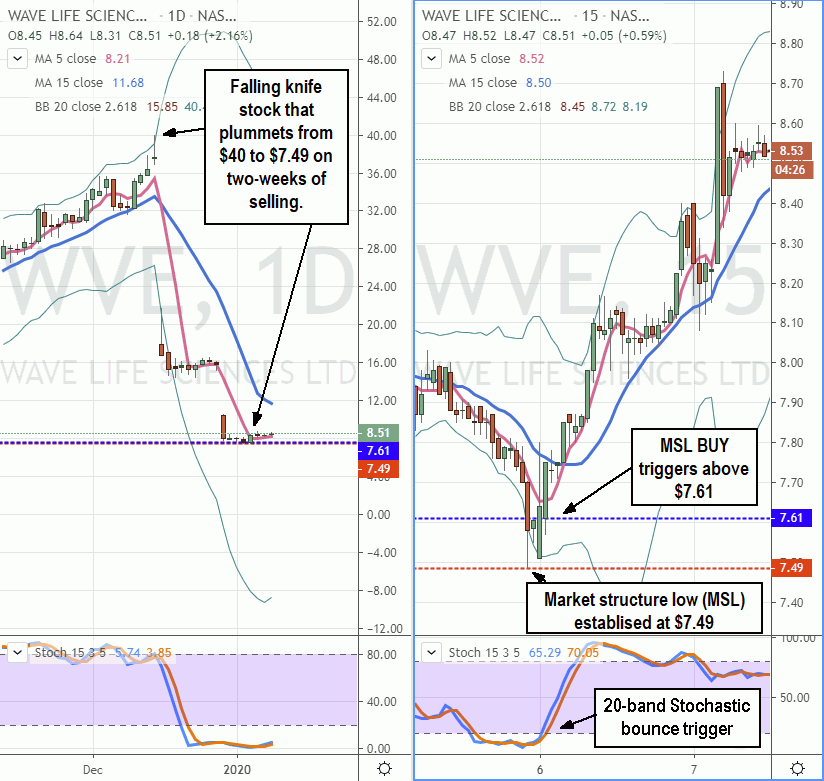Stocks that collapse sharply and continue to sell-off for extended periods of time are often deemed “falling knives”. Trying to catch a falling knife is akin to trying to time an entry on a collapsing stock with potentially dangerous consequences. Not all falling knives are the same and it’s critical to be aware of the risk and potential reward of taking on this task. Some falling knives may present an opportunity while others are a trap that lures in more bag holders. Utilizing a combination of
fundamental and
technical analysis can improve the chances of successfully navigating a reversal bottom.
What is a Falling Knife Stock?
Falling knife stocks experience a violent change in investor sentiment generally stemming from fundamental catalysts including earnings reports, analyst downgrades, newsletters/blogs, rumors, lawsuits or regulatory decisions. However, just because a stock plummets doesn’t immediately qualify it as a falling knife. Usually, shares suffer a sharp precipitous drop that continues to snuff out bounce attempts frustrating waves of buyers that get stopped out or trapped as shares fall perpetually lower breaking through multitudes of price support levels.
Preparation is Key
Be sure to define the playing field by being aware of the price support and resistance levels prior to the trades. Define your stop-loss conditions whether it’s price-based or indicator-based or both and the number of shares you will be playing. Pre-define your parameters especially the most important parameter which is your time frame for holding the position. The longer you hold a position, the more exposure and potential for further sell-off.
Define Your Time Frames
The basic rule of thumb is the shorter your holding period, the easier it is to play falling knives. The psychological problem occurs when traders get time frames mixed up. Catching a short-term bottom on a 5-minute chart but then second-guessing whether to take profits or hold “longer-term” as profits turn into losses thereby “trapping” the buyer who tries to justify his position. This is how bag holders are created. Be nimble, agile, reactive and disciplined.
Trading Intra-Day Market Structure Low Bottoms
Utilize the market structure low (MSL) pattern to define the buy trigger as well as the stop-loss. For extreme knives, it be sure to utilize a wider time frame to first establish an MSL then utilize smaller time frames to play the bounce. Intra-day time frames are key for immediate reactions. Utilize the stochastic oscillator on 20-band crossover up trigger combined with the MSL price trigger for entries. As for exits, you can use price levels (wider time frame moving average bumpers or Fibonacci levels) and/or indicator reversals (IE: stochastic 80-band slip).

Overnights and Swings Need Fundamentals
For overnight, swing and longer-term holds, it’s also important to have some fundamental premises in addition to the technical pattern. A dependable fundamental metric is when the cash-per-share (CPS) is higher than the price of the stock (IE: CPS is $11, and the stock gapped down to $9). Risk is defined as exposure which comes in the form of position size and holding time. The larger your position size and the longer you hold the position equates to higher risk. Keep in mind the goal is to minimize your risk with falling knives. This means to trim down the position size and/or holding time, especially if you’ve built up a buffer of profits. Holding positions overnight exposes you to additional risk especially when additional bad news hits. In the above example with Wave Life Sciences NASDAQ: WVE, there were two massive gaps down on news that occurred in the after-hours session collapsing shares from $37.60 to $17.95 on Dec. 19, 2019 and then $16.17 to $10.46 on Dec. 20, 2019. An MSL bottom didn’t occur under Jan. 3, 2020 at $7.49.
Earnings Season
With earnings season approaching, there will be a lot of falling knives to consider. Keep an eye on the peers for clues in addition to sector templates. For example, retail apparel stocks may be exhibit buoyancy on earnings gaps down for the first 90-minutes of the trading day. This can set the tone and template for upcoming retail earning reactions enabling you to time your entries earlier in the day. Make sure you pay attention to how prices react the days after a bad earning release and whether share continues lower or follow through on the recovery. Markets look to establish templates early on and then repeat until they become too transparent at which point, they reverse.
Before you make your next trade, you'll want to hear this.
MarketBeat keeps track of Wall Street's top-rated and best performing research analysts and the stocks they recommend to their clients on a daily basis.
Our team has identified the five stocks that top analysts are quietly whispering to their clients to buy now before the broader market catches on... and none of the big name stocks were on the list.
They believe these five stocks are the five best companies for investors to buy now...
See The Five Stocks Here
Nuclear energy stocks are roaring. It's the hottest energy sector of the year. Cameco Corp, Paladin Energy, and BWX Technologies were all up more than 40% in 2024. The biggest market moves could still be ahead of us, and there are seven nuclear energy stocks that could rise much higher in the next several months. To unlock these tickers, enter your email address below.
Get This Free Report
Like this article? Share it with a colleague.
Link copied to clipboard.